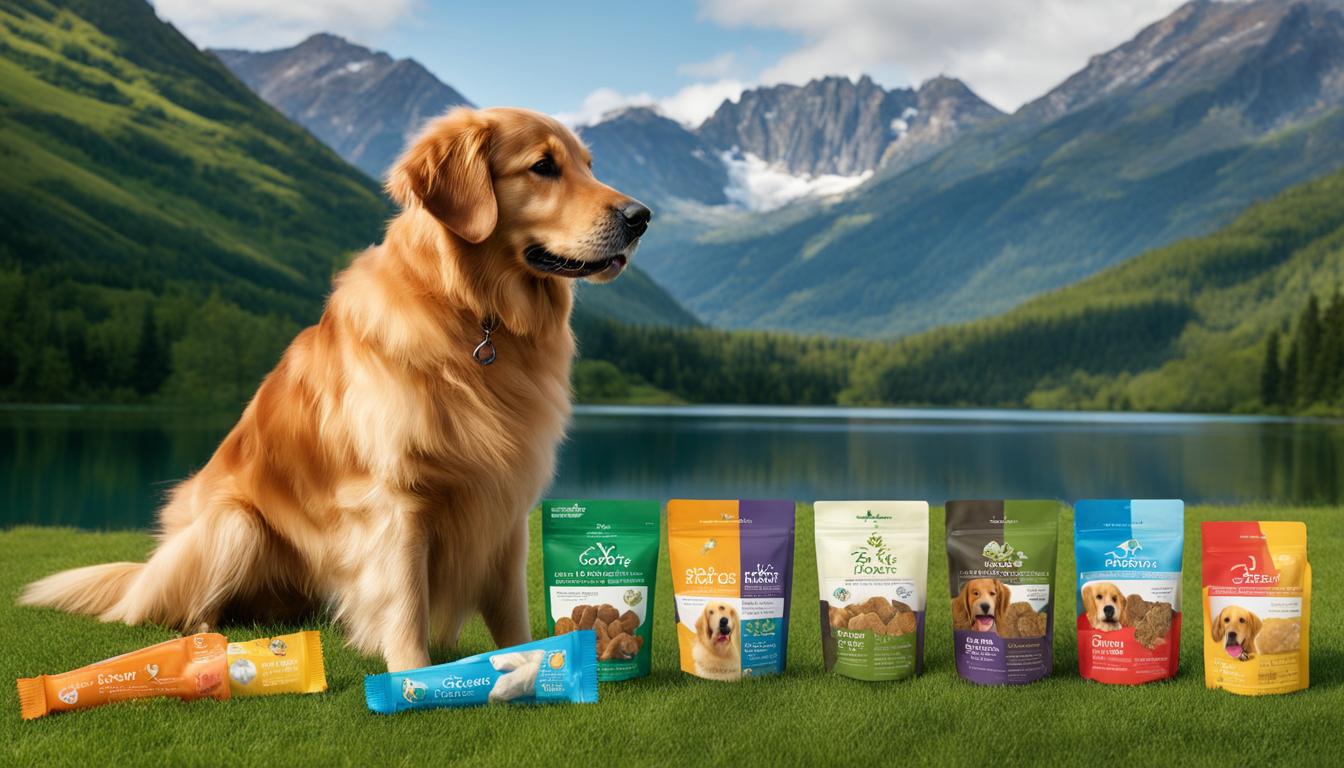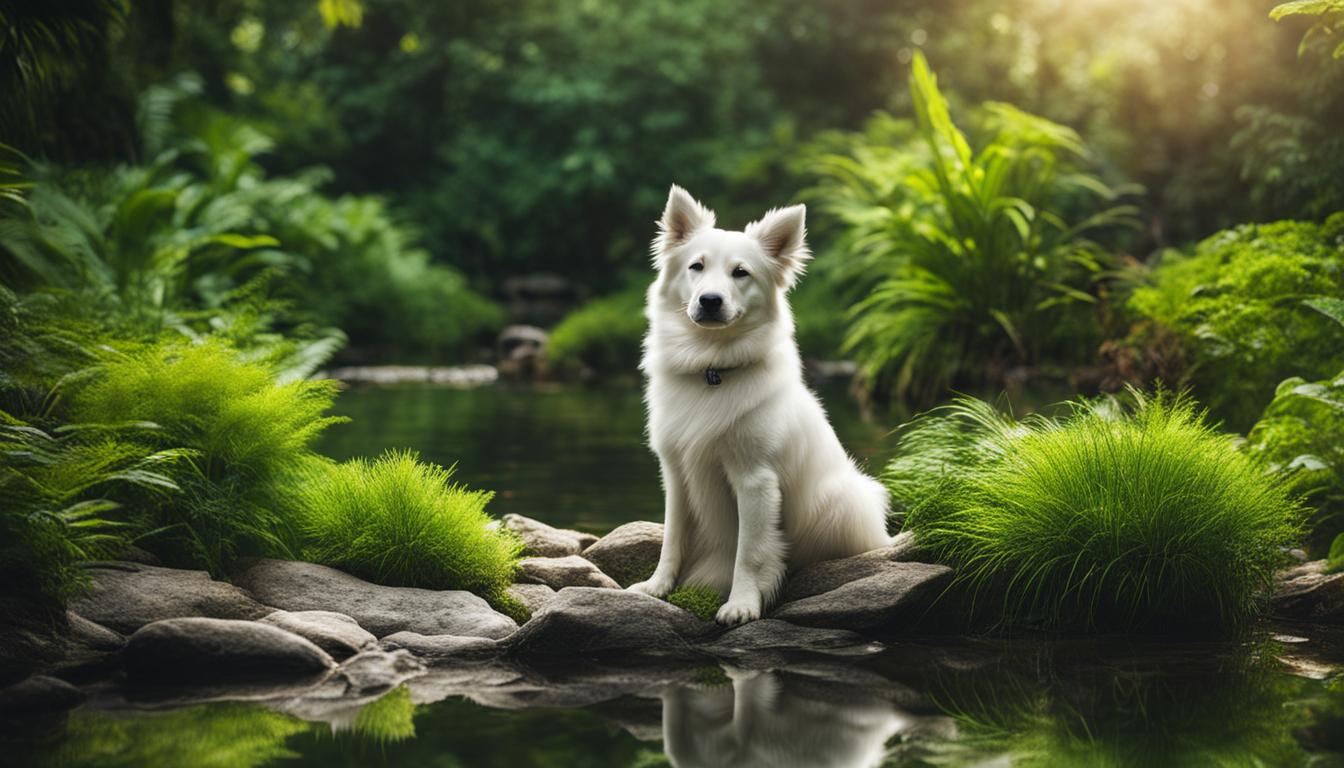When it comes to grooming our beloved furry friends, there’s no one-size-fits-all approach. Different dog breeds have unique grooming needs that require special attention and techniques. From breed-specific grooming to mixed breed considerations, understanding how dog breeds shape grooming techniques is essential for keeping our pups looking their best. So, let’s explore the world of breed and beauty in dog grooming!
Key Takeaways:
- Breed-specific grooming techniques are tailored to the specific needs of different dog breeds.
- Asian Fusion grooming is a creative style that aims to make dogs of all breeds look adorable.
- Mixed breed dogs require individualized grooming based on their unique characteristics and coat types.
- Long-haired, short-haired, and curly-coated breeds each have specific grooming considerations.
- Consulting with a professional groomer is essential for personalized advice.
The Beauty of Breed-Specific Grooming
When it comes to grooming your furry friend, understanding the specific needs of their breed is crucial. Different dog breeds have unique coat types and characteristics that require specialized grooming techniques. Whether you have a large breed or a small one, knowing how to groom them properly will help maintain their appearance and overall well-being.
For large breeds, such as Bulldogs and Retrievers, specialized grooming techniques are essential. These dogs often have thick coats that require regular brushing to prevent matting and keep their skin healthy. Additionally, their nails may grow faster and need more frequent trimming. By adopting breed-specific grooming tips, you can ensure that your large breed dog looks and feels their best.
On the other hand, small breed dogs like Chihuahuas and Pomeranians have their own unique needs. While their coats may be shorter, they still benefit from regular grooming to keep their skin clean and free from any irritations. Gentle grooming techniques, such as using a soft brush and appropriate grooming products, are recommended for these delicate breeds.
“Understanding the specific grooming needs of your dog’s breed will help you provide them with the proper care they deserve.”
Grooming Tips for Large Breeds
When it comes to grooming large breeds, there are a few key factors to keep in mind:
- Regular brushing to prevent matting and remove loose fur.
- Frequent nail trimming to maintain proper nail length.
- Using dog-friendly grooming products that suit their specific coat type.
- Scheduling regular baths to keep their skin and coat clean.
Grooming Tips for Small Breeds
If you have a small breed dog, here are some grooming tips to ensure their comfort and well-being:
- Gentle brushing to remove loose hair and prevent tangles.
- Regular ear cleaning to prevent ear infections.
- Nail trimming to keep their nails at an appropriate length.
- Using suitable grooming products for their sensitive skin.
Remember, each breed has its own set of grooming needs, so consulting with a professional groomer is always a good idea. They can provide personalized advice and recommendations based on your dog’s specific breed and coat type. By following breed-specific grooming tips, you can ensure that your furry friend stays happy, healthy, and looking their best.
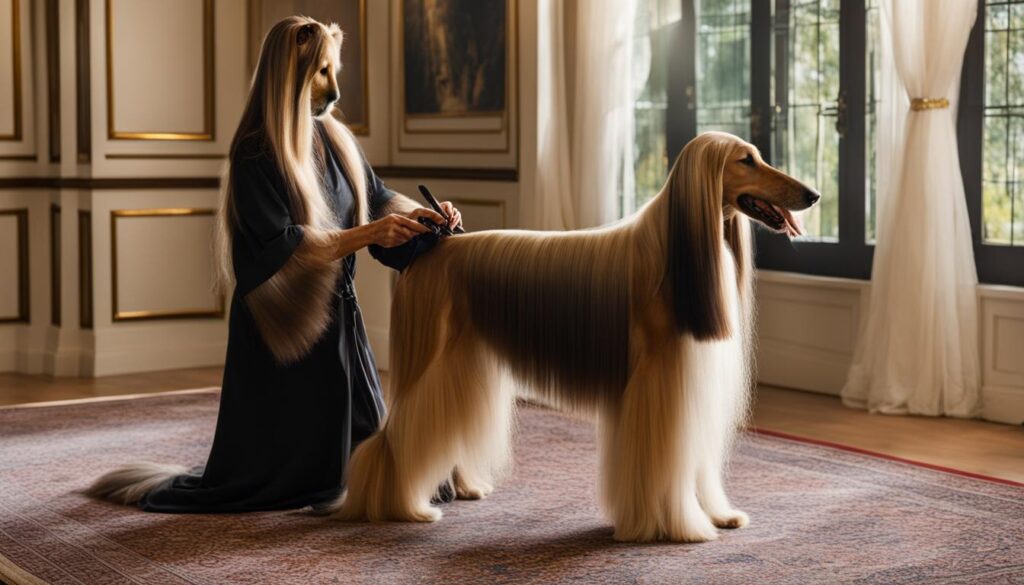
Grooming Tips for Mixed Breeds
When it comes to grooming mixed breed dogs, there are a few important considerations to keep in mind. Mixed breeds, also known as mutts or crossbreeds, often have a combination of traits from different breeds, including their coat types. Therefore, it’s crucial to adapt your grooming techniques to meet the unique needs of each individual dog.
One of the key factors to consider when grooming mixed breeds is their coat texture and length. Some mixed breeds may have hair that is more similar to one breed, while others may have a combination of both. This will determine the type of grooming tools and products you should use. For example, dogs with longer, thicker hair may require regular brushing to prevent matting, while those with shorter hair may benefit from occasional baths and shedding tools to keep their coat healthy.
Another important aspect of grooming mixed breeds is to take into account the dominant breed traits they inherit. For instance, if a mixed breed dog has a breed in their lineage that is prone to skin issues, it’s essential to be mindful of their skin health during grooming. Similarly, if a mixed breed has a breed with sensitive ears, extra care should be taken when cleaning their ears.
Grooming Tips for Mixed Breeds
| Grooming Considerations | Tips |
|---|---|
| Coat Texture and Length | Use appropriate grooming tools and products based on the dog’s coat type. Regular brushing for longer hair, occasional baths for shorter hair. |
| Dominant Breed Traits | Take into account any breed-specific considerations, such as skin issues or sensitive ears, during grooming. |
| Individual Needs | Adapt your grooming techniques to meet the specific needs of each mixed breed dog. Pay attention to their coat, skin, and overall comfort. |
Remember, every mixed breed dog is unique, so it’s important to approach grooming with flexibility and adaptability. By considering their individual characteristics and needs, you can help ensure that mixed breed dogs look and feel their best.
Consulting with a professional groomer can provide you with personalized advice and recommendations for your specific mixed breed. They can guide you on the best grooming techniques and products to use, ensuring that your furry friend receives the appropriate care and attention they deserve.
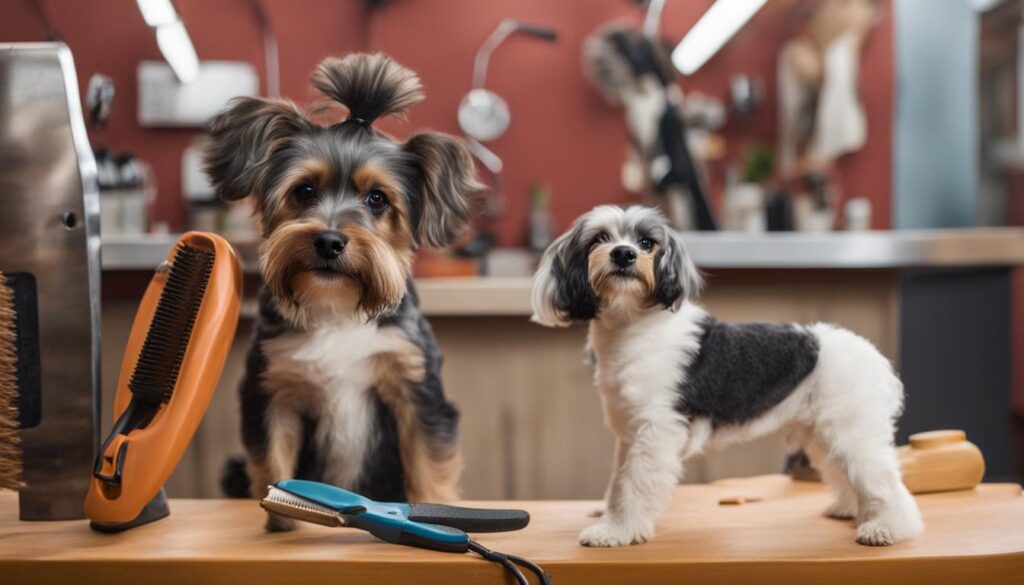
Grooming Tips for Long-Haired Breeds
If you have a long-haired breed like a Coton de Tulear or a Cavalier King Charles Spaniel, proper grooming is essential to keep their coats healthy and tangle-free. Here are some tips to help you maintain your long-haired dog’s luxurious locks:
Regular Brushing
Long-haired breeds require regular brushing to prevent matting and keep their coats looking shiny. Use a brush specifically designed for long hair and start from the roots, working your way down to the tips. Be gentle and patient to avoid causing any discomfort to your furry friend.
Trimming and Shaping
Occasional trimming or shaping can help keep your long-haired dog’s coat at a manageable length. Consulting with a professional groomer can ensure that the trimming is done correctly and in a way that enhances your dog’s appearance while maintaining a healthy coat.
| Grooming Tips for Long-Haired Breeds | |
|---|---|
| Regular Brushing | Prevents matting and keeps the coat shiny |
| Trimming and Shaping | Maintains a manageable coat length with the help of a professional groomer |
Professional Grooming
Consider taking your long-haired dog to a professional groomer for regular grooming sessions. Professional groomers have the experience and expertise to handle long hair and can provide specialized care to keep your dog’s coat in top condition.
Remember, each long-haired breed may have specific grooming needs, so it’s always a good idea to consult with a professional groomer or your veterinarian for personalized advice based on your dog’s breed and coat type.
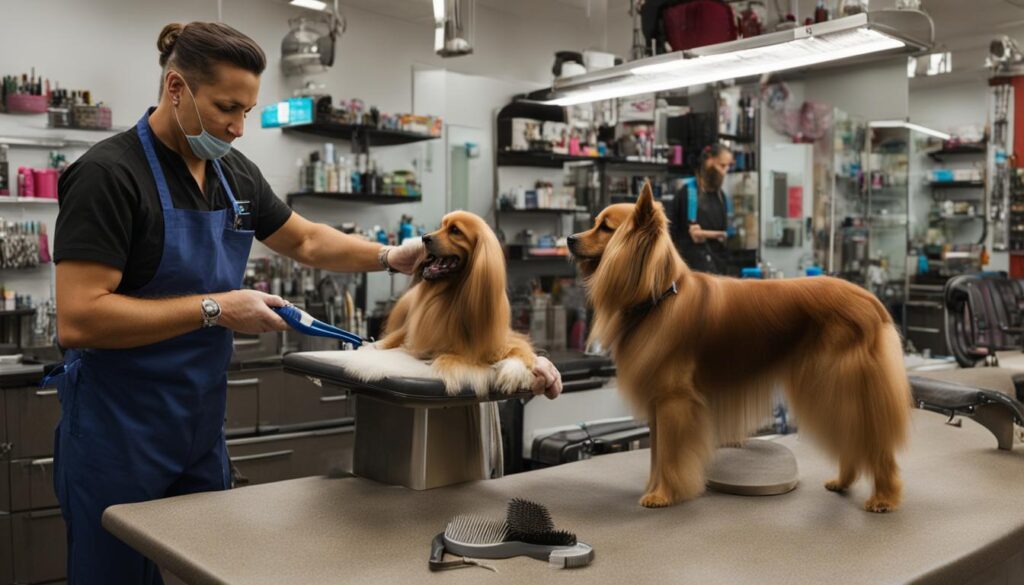
Grooming Tips for Short-Haired Breeds
Short-haired breeds, like French Bulldogs and Chihuahuas, may have different grooming needs compared to long-haired breeds. While their coats may not require extensive brushing, they still benefit from regular grooming to maintain their skin health and overall appearance. Grooming short-haired breeds may involve activities like bathing, nail trimming, and ear cleaning. Additionally, grooming can help detect any skin issues or abnormalities that may need further attention or veterinary care. Groomers should use gentle grooming techniques suitable for short-haired breeds to ensure a stress-free grooming session.
Here are some grooming tips specifically for short-haired breeds:
- Regular brushing: Even though short-haired breeds don’t have long coats, they can still shed and develop loose hair. Regular brushing helps remove any loose hair and stimulates the skin, promoting a healthy coat.
- Bathing: Short-haired breeds generally don’t require frequent baths, as their coats don’t easily trap dirt or odors. However, occasional bathing with a gentle shampoo specifically formulated for dogs can help keep their skin clean and healthy.
- Nail trimming: Just like any other dog, short-haired breeds need regular nail trims to prevent overgrowth and discomfort. It is important to use proper dog nail clippers and trim the nails carefully to avoid causing any pain or injury.
- Ear cleaning: Short-haired breeds are not exempt from ear problems like infections or wax buildup. Regular ear cleaning with a dog-friendly ear cleanser can help prevent such issues and promote good ear health.
Remember, even though short-haired breeds may require less grooming compared to long-haired breeds, regular grooming sessions provide an opportunity to bond with your furry friend and keep an eye out for any potential health concerns. Plus, a clean and well-groomed dog always looks and feels great!
For a visual representation of the grooming tips for short-haired breeds, refer to the table below:
| Grooming Tips for Short-Haired Breeds |
|---|
| Regular brushing |
| Bathing with a gentle shampoo |
| Nail trimming |
| Ear cleaning |
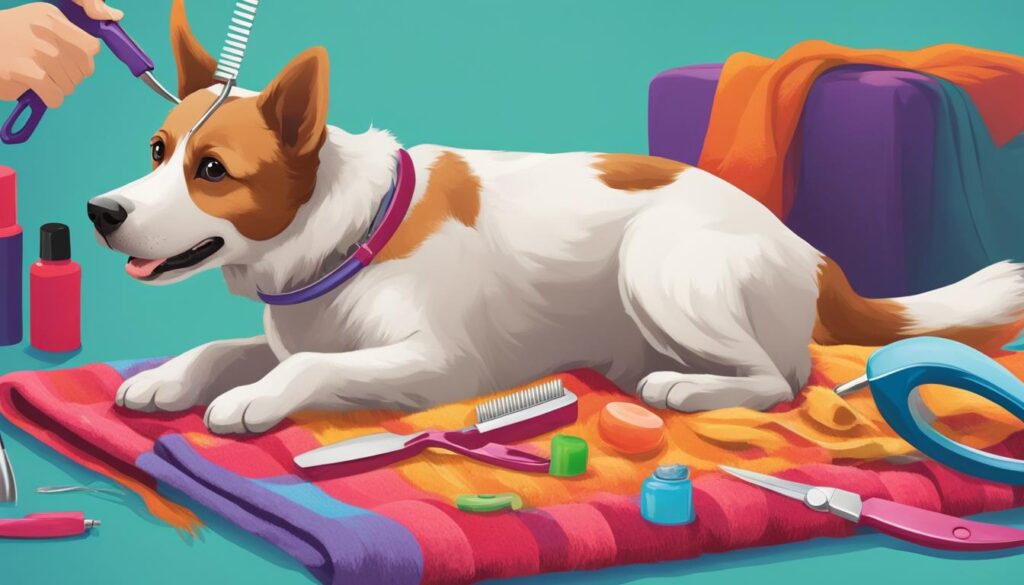
Grooming Tips for Curly-Coated Breeds
Grooming curly-coated breeds, such as Poodles and Bichons, requires special attention to maintain their unique and distinctive appearance. These breeds have curly fur that can easily become matted if not properly cared for. To keep your curly-coated dog looking their best, here are some grooming tips to follow:
Bathing
Curly-coated breeds should be bathed regularly to keep their coats clean and free from dirt and debris. Use a shampoo specifically formulated for curly or textured hair to enhance the curl and maintain the coat’s natural oils. After shampooing, be sure to thoroughly rinse your dog’s coat to remove any leftover residue.
Brushing and Detangling
Regular brushing is essential for curly-coated breeds to prevent matting and remove any tangles. Use a slicker brush or a comb with wide teeth to gently work through the curls. Start at the ends of the hair and gradually work your way up to the roots, being careful not to pull or tug on the hair. If you encounter any stubborn tangles, use a detangling spray or conditioner to help loosen them before brushing.
Professional Grooming
Curly-coated breeds often benefit from professional grooming to maintain their signature look. A professional groomer will have the knowledge and skills to properly trim and shape the coat, ensuring that it stays in the desired style. Regular grooming appointments can help prevent matting and keep your dog’s coat healthy and manageable.
Remember, each curly-coated breed may have specific grooming needs, so it’s important to consult with a professional groomer or research breed-specific grooming techniques for the best results. By following these grooming tips, you can help your curly-coated dog look their best and stay comfortable.
Conclusion
Grooming techniques for different dog breeds vary based on their unique characteristics, including coat type, length, and texture. Breed-specific grooming techniques help maintain the appearance and well-being of different breeds, whether they have long, short, or curly coats. By understanding and implementing these grooming techniques, you can keep your furry friend looking and feeling their best.
When it comes to grooming, it’s important to consider the specific needs of your dog’s breed. Whether you have a Poodle, a Chihuahua, or a mixed breed, tailoring your grooming routine to their individual coat requirements is key. Regular brushing, bathing, and grooming can prevent matting, tangles, and skin issues, while also allowing you to bond with your pet.
Remember, consulting with a professional groomer can provide personalized advice and recommendations for your dog’s specific breed and grooming needs. They can guide you on the best techniques, tools, and products to use for optimal results. So, pamper your pup and give them the spa treatment they deserve!
Now that you have a better understanding of breed-specific grooming techniques, you can confidently embark on the journey of keeping your furry friend looking their best. Whether it’s a Poodle with a perfectly styled coat or a mixed breed with a unique combination of traits, your grooming efforts will ensure that your dog stands out from the pack.
FAQ
What is Asian Fusion grooming?
Asian Fusion grooming is a popular trend in dog grooming that originated in Asian countries like Korea, Japan, and China. It involves transforming dogs into whimsical and playful styles that resemble toy lambs or cartoon characters.
Which breeds are suitable for Asian Fusion grooming?
Asian Fusion grooming is suitable for breeds with dense, curly coats, and is often used on breeds like Poodles, Bichons, and Shih Tzus.
What are some grooming considerations for specific dog breeds?
Poodles have thick, puffy coats that can be groomed into various shapes and styles. Afghan Hounds have luxurious coats that flow freely and require regular brushing. Maltese dogs are prone to matting and need frequent grooming to prevent tangles. Puli and Komondor dogs have corded coats, which require special care to prevent matting. Yorkshire Terriers are known for their long locks that can be styled into glamorous looks.
How should I groom mixed breed dogs?
When it comes to grooming mixed breeds, it’s important to consider their individual characteristics and coat types. Groomers should take into account the unique coat care requirements of mixed breeds and adapt their grooming techniques accordingly.
What grooming techniques are suitable for long-haired breeds?
Long-haired breeds, such as Coton de Tulear and Cavalier King Charles Spaniels, require regular grooming to keep their coats healthy and tangle-free. Brushing their long hair helps prevent matting and keeps the coat looking shiny and well-maintained.
How should I groom short-haired breeds?
Short-haired breeds, like French Bulldogs and Chihuahuas, may not require extensive brushing, but they still benefit from regular grooming to maintain their skin health and overall appearance. Grooming short-haired breeds may involve activities like bathing, nail trimming, and ear cleaning.
What are some grooming tips for curly-coated breeds?
Curly-coated breeds, such as Poodles and Bichons, have unique grooming needs due to the nature of their curly fur. Regular brushing is essential to prevent matting and keep the coat healthy. Curly-coated dogs may require specialized grooming techniques, including scissoring and shaping, to maintain their distinctive curly appearance.



